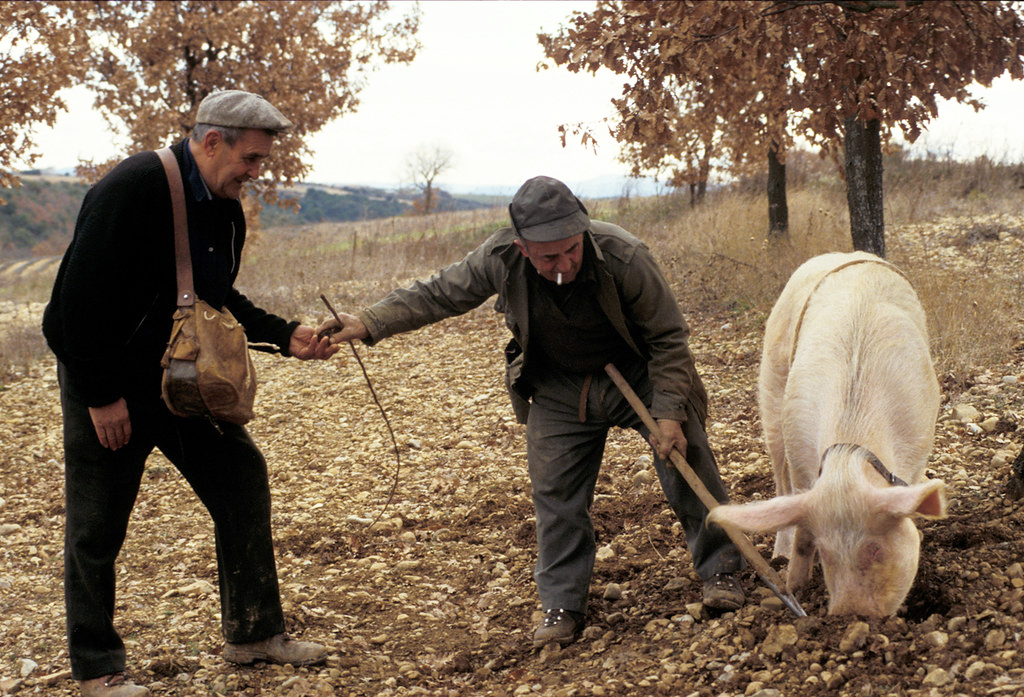The Millionaire’s Mushroom…
Some think its fleeting, heady perfume evocative and divinely sensual. Others rate it simply as a gourmet’s delight. Personally I reckon the truffle’s scent is unmistakably and un-apologetically carnal – reminding me of the muskiness of an unmade bed after an afternoon of love in the tropics..
On the aphrodisiac scale it scores alongside oysters, chocolate and bulls’ testicles – reinforced by literary references as to its ability to ‘make one’s loins smoulder like those of randy lions’ (Balzac), and of being ‘the luxury of wealthy men and their kept women’ (Brillat-Savarin). Combine this with its reputation of having capacitated Napoleon into conceiving his only legitimate son, and it is not hard to grasp why so many revere this insignificant, ugly, underground mushroom. Such indeed was the truffle’s reputation, that the Catholic Church excluded it from its celebratory feasts, believing it to be the embodiment of lust and evil.
But whatever opinion we may have of this black, knobbly fungus, its reputation almost always precedes our actual experience of it. (I remember hesitating – albeit at the age of 16 and for only one second – before undertaking my first sampling of it.) Furthermore, whatever claims are made, much of the truffle’s secrets remains shrouded in mystery. So what are the true facts of this ugly fungus and why all the fuss?
Well, truffles can be either black (also known as melanospora) or white (magnata). Other varieties do exist but are not as highly prized. They grow underground, usually close to the roots of certain species of shrub oaks and hazel trees. Truffle hunters used to rely on luck to find them and have, for centuries, depended on sows to locate them. Turn a sow loose in a truffle orchard, and she’ll sniff like a bloodhound. And then she’ll dig with manic passion. Why? It all boils down to androstenol – a male pig hormone. Research has shown truffles to contain twice the amount of androstenol that is found in a male pig – hence the sow’s interest. The fact that boar pheromones are chemically close to human male hormones probably explains why we too find the scent of truffles arousing.
Here I would like to pause and give a thought to the poor frustrated sow. Imagine her trotting through a truffle orchard that seems, to her, positively vibrating with sexy boars – every single one panting for her. Yet all of these potential lovers are for some inexplicable reason doing their panting underground. So here she is, driven wild with desire, and so to fulfill her passionate cravings she starts digging. And then? Not only does all that frantic digging merely lead to a strange, lumpy, splotched mushroom, but then the farmer snatches it away from her! All she can do is try digging for another potential suitor… I cannot think of a sadder story, can you?
For most of us truffles are simply a luxurious treat, one that perhaps borders on hedonistic gluttony. And not many of us can afford them very often. Because of their high price, truffles are shaved into very thin slivers, then added to pasta and egg dishes or stirred into risotto, thinly sliced beef and shellfish – its decadent perfume pervades everything it comes in touch with. Black truffles cost around 500€ a kilo, whereas white Italian truffles can fetch as much as 1000€ a kilo at the connoisseurs’ market in Albi. The most reliable markets inspect and vet their truffles to make sure that amateurs no longer risk being bamboozled into buying heavy, clay-covered or even fake specimens for the same exorbitant cost. Its season starts in December and finishes in March.
One word of warning: If you buy any ready-made truffle products (from oils and crisps to flavoured salts) remember that the word “aroma” is a red flag – in most cases this is just another word for artificial flavouring. “Essence” is a made-up word when it comes to truffles. Whereas “steeped and crushed fresh truffles” is also impossible because the truffles would just lose their flavour in about a day.
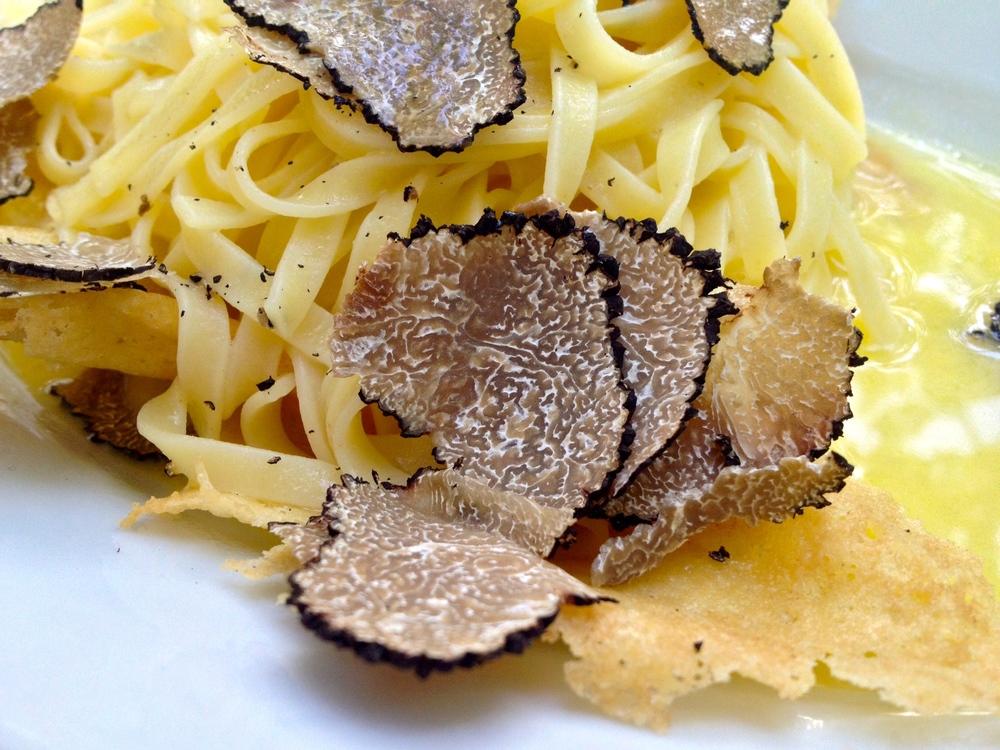
The Truffle Market of RICHERENCHES
It is the end of January and I’m on my way to what is one of France’s largest and most famous of truffle markets – Richerenches, in Haute Provence. It is a sunny but crisp winter morning when we set out, driving through a landscape that is dotted with immaculately kept vineyards, plane tree lined avenues, sandstone farmhouses with pale-grey shutters and leafless vine-covered pergolas. Here and there patches of land are still covered with the white morning frost, and black-bereted men in blue denim can be seen, hands tucked deep into their pockets, inspecting their dormant crops.
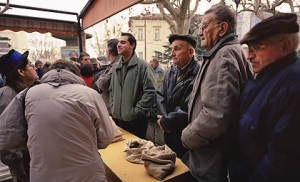 It is 10 am and at the open-air market, farmers and brokers are poised for business. There is no dealing yet – everyone huddles in small groups, stamping their feet against the cold, measuring each other up from underneath the rims of their caps. There seems a lot of bragging and bluffing and teasing going on but the car boots remain firmly closed. Small-time truffle hunters roam from dealer to dealer, rustling a plastic or paper bag, occasionally allowing someone a furtive glance or a quick sniff at its content. Men with dirt under their fingernails and last night’s garlic on their breath huddle around a shabby old van. Behind them several rows of arching necks are trying to glimpse at the treasures on offer.
It is 10 am and at the open-air market, farmers and brokers are poised for business. There is no dealing yet – everyone huddles in small groups, stamping their feet against the cold, measuring each other up from underneath the rims of their caps. There seems a lot of bragging and bluffing and teasing going on but the car boots remain firmly closed. Small-time truffle hunters roam from dealer to dealer, rustling a plastic or paper bag, occasionally allowing someone a furtive glance or a quick sniff at its content. Men with dirt under their fingernails and last night’s garlic on their breath huddle around a shabby old van. Behind them several rows of arching necks are trying to glimpse at the treasures on offer.
 At 11.30 a frisson ripples through the crowd. After all the strutting and boasting and haggling, it seems a price has been established. Today this is somewhere between 900 and 1100 euros a kilo. Car boots are opened and the strong, intoxicating scent of truffles suddenly pervades the air. Its provocativeness is almost too much. At one stall a man cooks truffled omelettes on a portable gas cooker, offering small pieces to potential customers. Buyers dressed in expensive leather jackets stand beside their gleaming BMW and Mercedes cars, many with Swiss number plates. They drop their noses into plastic bags and if they like what they see, the loot is weighed by means of ancient hand-scales and offers are made. Everyone watches intently as wads of crisp Euros are double-checked with much licking of thumbs and glancing over shoulders. Cheques are not accepted and receipts are never issued because truffistes are not eager to participate in that daft government ploy the rest of us call taxation. One vendor has only seven truffles left – he’s been selling them at 150 euros a pop.
At 11.30 a frisson ripples through the crowd. After all the strutting and boasting and haggling, it seems a price has been established. Today this is somewhere between 900 and 1100 euros a kilo. Car boots are opened and the strong, intoxicating scent of truffles suddenly pervades the air. Its provocativeness is almost too much. At one stall a man cooks truffled omelettes on a portable gas cooker, offering small pieces to potential customers. Buyers dressed in expensive leather jackets stand beside their gleaming BMW and Mercedes cars, many with Swiss number plates. They drop their noses into plastic bags and if they like what they see, the loot is weighed by means of ancient hand-scales and offers are made. Everyone watches intently as wads of crisp Euros are double-checked with much licking of thumbs and glancing over shoulders. Cheques are not accepted and receipts are never issued because truffistes are not eager to participate in that daft government ploy the rest of us call taxation. One vendor has only seven truffles left – he’s been selling them at 150 euros a pop.
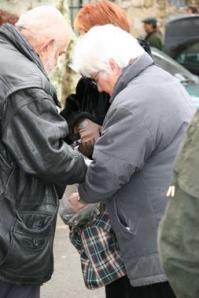 By midday, both buyers and sellers look happy. Tomorrow their truffles can be found in the kitchens of Michelin-starred restaurants across Europe. Or perhaps in the chic Parisian delicatessens of Fauchon and Hediard and at Harrods’s fine foods counter. (The latter do accept cheques of course – only you’ll be paying three times the price). Further along the market stalls a woman takes advantage of people’s bonne humour and sells freshly picked, flowering mimosa branches. Another peddles dried ceps, salty olives and pungent salamis. Her neighbour hawks homemade quince preserves to eat with the pungent goatscheeses that her compatriot nextdoor is selling together with his truffled olive oil. The man beside him has a stack of oak saplings which he promises are mycorhizés or “injected with truffle spores” for those who fancy ‘growing their own’..
By midday, both buyers and sellers look happy. Tomorrow their truffles can be found in the kitchens of Michelin-starred restaurants across Europe. Or perhaps in the chic Parisian delicatessens of Fauchon and Hediard and at Harrods’s fine foods counter. (The latter do accept cheques of course – only you’ll be paying three times the price). Further along the market stalls a woman takes advantage of people’s bonne humour and sells freshly picked, flowering mimosa branches. Another peddles dried ceps, salty olives and pungent salamis. Her neighbour hawks homemade quince preserves to eat with the pungent goatscheeses that her compatriot nextdoor is selling together with his truffled olive oil. The man beside him has a stack of oak saplings which he promises are mycorhizés or “injected with truffle spores” for those who fancy ‘growing their own’..
But it’s time to leave the action – a truffled lunch awaits us in Bouchet – in a simple small inn called L’Auberge de la Poste. It is warm and cosy inside and we sit down immediately. No apero is offered for who would want to kill the delicate truffle flavours with an overpowering pastis? Our starter is a buttery potato dish, dotted with slivers of truffle – the ultimate comfort dish to warm the cockles of our tastebuds. En suite we are served small puff pastries, light as a feather, stuffed with foie gras and generously sprinkled with copeaux of truffles. Next is a light fluffy omelette studded with yet more truffles and with each course we drink a different local wine.
Later that night we were to eat more truffle-scented food in the splendid surroundings of nearby Chateau de Rochegude – think grilled scallops with beurre blanc and grated truffles, truffled artichokes, tender veal with truffles.. But first, after lunch, a visit to a truffle orchard has been planned.
TRUFFLE HUNTING
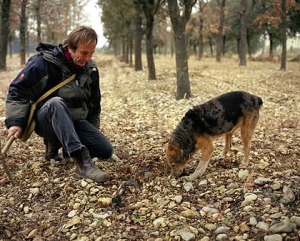 Nowadays sows have been replaced by more easily-handled dogs. Unlike pigs however, the chiens truffiers do not instinctively sniff out truffles and must be trained for this work.
Nowadays sows have been replaced by more easily-handled dogs. Unlike pigs however, the chiens truffiers do not instinctively sniff out truffles and must be trained for this work.
It is a labour-intensive and unpredictable business and truffle hunters, like good journalists, protect their sources. For the latter however, watching a truffiste at work can be a dangerous preoccupation – especially if he has a wife.. “ies iet ma ‘ousband you make en photo?” she demanded brusquely, taking a swipe at my camera. I volunteer that I merely take pictures to illustrate my article.
 She snorts and looks accusingly towards her husband who seems quite pleased with the attention, seeing as he has by now draped himself seductively over a leaning tree. This does not convince her of my innocence, and she attempts a rugby tackle. Monsieur le mari meanwhile relishes in the struggle and continues to make sure that his profile is at all times perfectly angled for my lens – something that encourages his wife to try another few clever moves.
She snorts and looks accusingly towards her husband who seems quite pleased with the attention, seeing as he has by now draped himself seductively over a leaning tree. This does not convince her of my innocence, and she attempts a rugby tackle. Monsieur le mari meanwhile relishes in the struggle and continues to make sure that his profile is at all times perfectly angled for my lens – something that encourages his wife to try another few clever moves.
 But the worry about others’ marital demeanors need not have kept me awake all night, for it appeared that all had been forgiven the next day – at the Truffle Mass celebrated in honour of Saint Antoine, the patron saint of truffle growers. Comme d’habitude parishioners are asked to donate generously, and as members of the Confrerie du Diamant Noir, in full ceremonial regalia, pass around the collection baskets, large truffles join banknotes, and once again the evocative scent fills the air.
But the worry about others’ marital demeanors need not have kept me awake all night, for it appeared that all had been forgiven the next day – at the Truffle Mass celebrated in honour of Saint Antoine, the patron saint of truffle growers. Comme d’habitude parishioners are asked to donate generously, and as members of the Confrerie du Diamant Noir, in full ceremonial regalia, pass around the collection baskets, large truffles join banknotes, and once again the evocative scent fills the air.
 I notice Madame La Truffiste who now sports a heavenly smile on her face as she generously contributes a handsome black specimen towards the worthy cause.
I notice Madame La Truffiste who now sports a heavenly smile on her face as she generously contributes a handsome black specimen towards the worthy cause.
Because let’s face it, what after all would the flutterings of love and marriage be without the truffle?
Copyright Petra Carter

